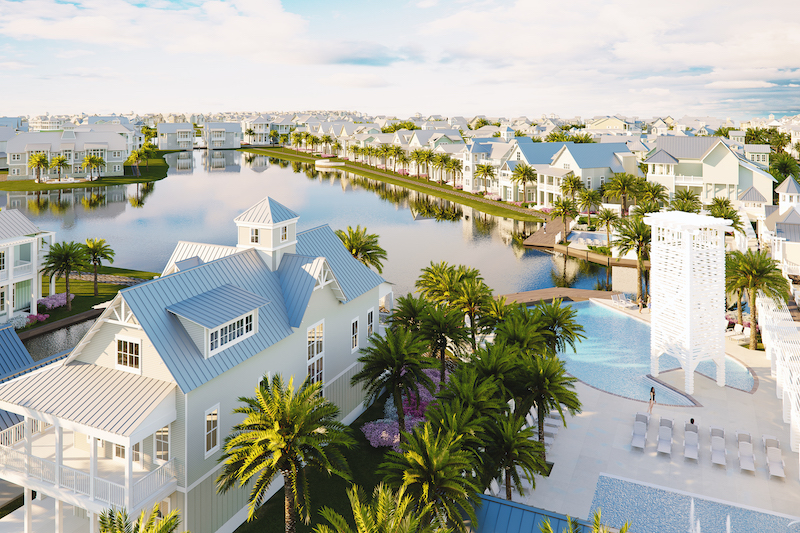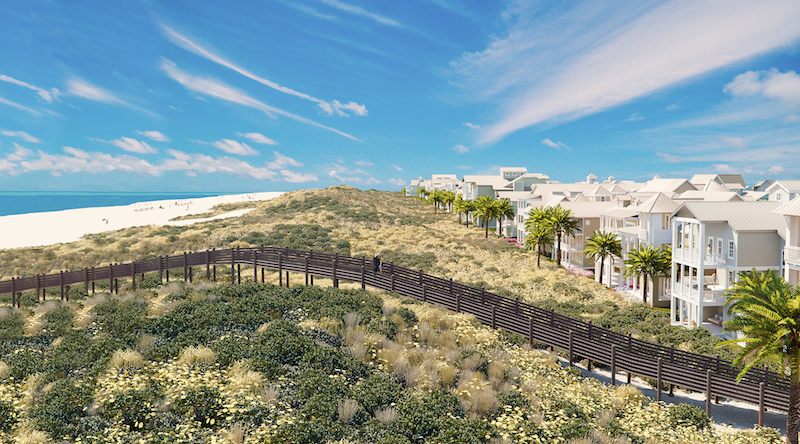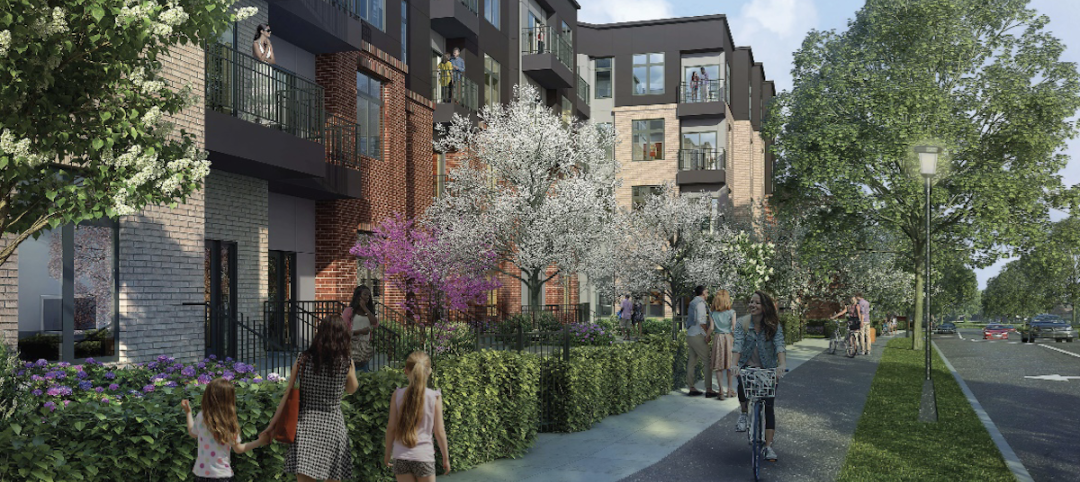Port Aransas is a city on Mustang Island, an 18-mile-long barrier island on the eastern coast of Texas along the Gulf of Mexico, about 180 miles southeast of San Antonio. The city is a fishing, beach, and resort village with 4,000 local residents and five million visitors per year, according to the local Chamber of Commerce. Eco-tourism is one of its economic focuses.
After incurring major damage from Hurricane Harvey in August 2017, Port Aransas has been attracting new development that includes the city’s first conference center, for assemblies of between 500 and 2,000 people, which is scheduled to open in 2021. A 225-key hotel-conference center is slated to break ground next February, as is a new marina/ resort sometime next year.
Port Aransas is also where three upscale mixed-use communities are under development or expansion. These include:
•Cinnamon Shore South—a $1.3 billion, 300-acre subdivision within the 1,000-acre Cinnamon Shore beachfront master planned community—will include luxury homes, Town Center residences, community pools, dining and retail districts, a boutique hotel and a health and wellness center.
•Last June, Palmilla Beach Resort & Golf Community, developed and owned by McCombs Properties, opened a nine-hole golf course, plus a three-hole par-3 course with driving range called The Loop. Palmilla offers condos, townhouses, cottages, and custom homes, starting from the $500s. MPA Austin and Cornerstone Architects are the architects, Schnell Urban Design the design consultant and land planner, and Fortis Homes, Turichhi Builders, Arbogast Home and Pelican Custom Homes the residential contractors.
•Sunflower Beach Resorts & Residences, situated within 50 acres of protected dune reserves, has nearly completed its first phase of The Camp, consisting of 25 luxury one- and two-bedroom cabins priced from $382,000 to $499,000. The community itself features beach homes, 21 single-level poolside condos, and several buildable lots. The Camp’s developers are BMG Wonderland and Legacy DCS.
Sea Oats Group is the developer of Cinnamon Shore. Its CEO, Jeff Lamkin, tells BD+C that the first phase of Cinnamon Shore South, which broke ground a year ago, has eight of the first 20 homes under construction. The build-out of Cinnamon Shore South is expected to encompass around 1,000 housing units, and take between 15 and 20 years to complete.

The houses under construction at Cinnamon Shore South are all elevated and built to resist flooding and high winds.
The elevations of all of the buildings in this subdivision will be 10 to 11 feet above sea level. Lamkin says the street is 6½ feet above, and the buildings will sit on leakproof elevated slabs over sand fill that’s another 4½ feet above street level.
The Texas Gulf Coast is perennially susceptible to high winds. Lamkin says that for resilience, the houses at Cinnamon Shore South will include bolts placed every 18 inches around the perimeter that secure the roof to the foundation. The houses’ windows can resist winds up to 140 miles per hour. Sea Oats is specifying 32-gauge aluminum roofing, Azek decking, and Hardiplank siding. The community was designed so there’s not a lot of debris when winds kick up.
(Cinnamon Shore South’s building team includes Kissling Architecture and the Waggoner Custom Homes.)
Lamkin says that before Sea Oats considers developing beachfront property, it compares old and new shoreline imagery to determine accretion, stability, and erosion. It also looks at the post-storm durability of the property’s dune system; Cinnamon Shore’s dunes are between 14 and 30 ft high, and 300 ft wide, he says.
Lamkin calculates that resilience can double the cost of construction for coastal projects. Sea Oats spent $600,000 alone to build a dune crossover to the community’s golf course.
But Port Aransas’ marketing pitch is that it offers luxury living at a bargain compared to similar homes and communities in coastal Florida or California. Fifty-foot Gulf-front lots there are still selling for under $1 million, versus $4 million to $5 million in Florida or California. “Coastal homes in Texas might sell for $3 million, compared to $9 million in Florida and $12 million in California, mostly because the cost of land,” Lamkin explains.
When asked why it took so long for developers to leap into beachfront property like Port Aransas, Lamkin—whose company started the 63-acre Cinnamon Shore North in 2007—says that Texas’ economy has shifted from depending on gas and oil for 70% of its tax revenue in the 1980s, to where that sector contributes only about 20% today. Other sectors, like tourism and entertainment, have been picking up the slack.
It hasn’t hurt, either, that the housing market in Texas is still relatively inexpensive, vis a vis other markets on the east and west coast. And Texas led all states in terms of seasonally adjusted annual job growth by adding 323,000 jobs from July 2018 to July 2019, according to the Texas Workforce Commission. These factors have driven Texas’ population to exceed 29 million, from 25.1 million in 2010.
Related Stories
Multifamily Housing | Apr 12, 2024
Habitat starts leasing Cassidy on Canal, a new luxury rental high-rise in Chicago
New 33-story Class A rental tower, designed by SCB, will offer 343 rental units.
MFPRO+ News | Apr 10, 2024
5 key design trends shaping tomorrow’s rental apartments
The multifamily landscape is ever-evolving as changing demographics, health concerns, and work patterns shape what tenants are looking for in their next home.
Mixed-Use | Apr 9, 2024
A surging master-planned community in Utah gets its own entertainment district
Since its construction began two decades ago, Daybreak, the 4,100-acre master-planned community in South Jordan, Utah, has been a catalyst and model for regional growth. The latest addition is a 200-acre mixed-use entertainment district that will serve as a walkable and bikeable neighborhood within the community, anchored by a minor-league baseball park and a cinema/entertainment complex.
Multifamily Housing | Apr 9, 2024
March reports record gains in multifamily rent growth in 20 months
Asking rents for multifamily units increased $8 during the month to $1,721; year-over-year growth grew 30 basis points to 0.9 percent—a normal seasonal growth pattern according to Yardi Matrix.
Industry Research | Apr 4, 2024
Expenses per multifamily unit reach $8,950 nationally
Overall expenses per multifamily unit rose to $8,950, a 7.1% increase year-over-year (YOY) as of January 2024, according to an examination of more than 20,000 properties analyzed by Yardi Matrix.
Affordable Housing | Apr 1, 2024
Biden Administration considers ways to influence local housing regulations
The Biden Administration is considering how to spur more affordable housing construction with strategies to influence reform of local housing regulations.
Affordable Housing | Apr 1, 2024
Chicago voters nix ‘mansion tax’ to fund efforts to reduce homelessness
Chicago voters in March rejected a proposed “mansion tax” that would have funded efforts to reduce homelessness in the city.
Standards | Apr 1, 2024
New technical bulletin covers window opening control devices
A new technical bulletin clarifies the definition of a window opening control device (WOCD) to promote greater understanding of the role of WOCDs and provide an understanding of a WOCD’s function.
Adaptive Reuse | Mar 26, 2024
Adaptive Reuse Scorecard released to help developers assess project viability
Lamar Johnson Collaborative announced the debut of the firm’s Adaptive Reuse Scorecard, a proprietary methodology to quickly analyze the viability of converting buildings to other uses.
Green | Mar 25, 2024
Zero-carbon multifamily development designed for transactive energy
Living EmPower House, which is set to be the first zero-carbon, replicable, and equitable multifamily development designed for transactive energy, recently was awarded a $9 million Next EPIC Grant Construction Loan from the State of California.

















